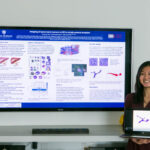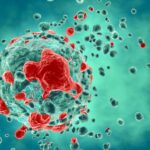Peptide noodles align to enhance nanoscale energy conduction
Everyone knows that uncooked spaghetti starts off aligned and ordered in the box but changes into a tangled mass of pasta once boiled in water. Imagine how difficult it would be to try to realign the spaghetti noodles.
Researchers in the chemistry laboratory of assistant professor J.D. Tovar at Johns Hopkins University have been making self-assembling nanowires made up of short peptide molecules with engineered electronic functions that have the potential for direct electronic interfacing with cells. The problem was, Tovar’s nanowire production method favored the fibers to form randomly jumbled networks, much like cooked spaghetti noodles on a plate. In that disordered arrangement, it would be difficult to control their alignment or allow them to interface with cells.
So Tovar and his PhD student, Brian Wall, turned to postdoctoral fellow Shuming Zhang from the lab of associate professor Hai-Quan Mao in the Department of Materials Science and Engineering in the Whiting School of Engineering. Wall, who is lead author on the paper recently published online in Advanced Materials, worked closely with Zhang and Stephen Diegelmann, one of Tovar’s former PhD students.
Together, the team created noodle-like arrays made up of self-assembling nanowires that all line up in the same direction to form thicker bundles with electrically conductive properties. Polarized optical microscopy and scanning electron microscopy were used to confirm that individual nanowires were nearly perfectly aligned within each noodle bundle.
With the help of PhD student Thomas Dawidczyk from the laboratory of the Howard Katz, professor and chair of Materials Science and Engineering, the team demonstrated that better alignment increases the fiber bundle’s ability to conduct electricity, Tovar said. The nanowire bundles “resemble a large electrical cable made up of individual wires,” Tovar added.
The long-term goal of the project is to use the nanowire noodles to forge electronic bridges with living cells or energy-relevant proteins. Tovar said improved nanowire alignment also is important to developing applications in tissue engineering. The aligned structure and peptide nature of these scaffold materials make it easier to functionalize these materials to guide cell growth.
The noodle fabrication technique involves the injection of a solution of peptide precursor molecules into another solution that facilitates the assembly of individual molecules into nanowires that are collectively aligned within the resulting noodle.
“It’s a method of making molecules into macro structures in one simple step,” Tovar said. The resulting noodle assemblies are up to a millimeter in diameter and several centimeters long. The next step, said Wall, will be finding ways to mass-produce and automate conductive noodle fabrication and develop them into functional devices.
Funding for this work was provided by a seed grant from Johns Hopkins Institute for NanoBioTechnology, the Department of Energy Office of Basic Energy Sciences, the National Science Foundation and the Maryland State Stem Cell Research Fund. The paper, “Aligned Macroscopic Domains of Optoelectronic Nanostructures Prepared via Shear-Flow Assembly of Peptide Hydrogels,” appears online prior to print in the journal Advanced Materials. Diegelmann was a Johns Hopkins Institute for NanoBioTechnology Integrative Graduate Education and Research Traineeship fellow. Additional authors on this research include William Wilson, formerly of the Johns Hopkins Integrated Imaging Center, who used confocal microscopy to explore the unusual electronic properties of the noodle assemblies.
J.D. Tovar’s INBT Faculty Profile
Story by Mary Spiro
Latest Posts
-
 Q&A with PSON Intern Jocelyn Hsu
August 19, 2021
Q&A with PSON Intern Jocelyn Hsu
August 19, 2021
-
 Start Up Founders from Johns Hopkins Aim to Stop Spread of Cancer
August 3, 2021
Start Up Founders from Johns Hopkins Aim to Stop Spread of Cancer
August 3, 2021
-
 Protein Appears to Prevent Tumor Cells from Spreading Via Blood Vessels
July 15, 2021
Protein Appears to Prevent Tumor Cells from Spreading Via Blood Vessels
July 15, 2021


